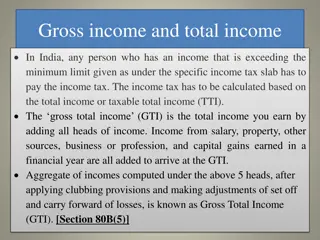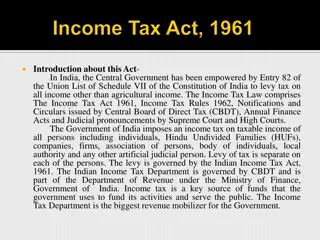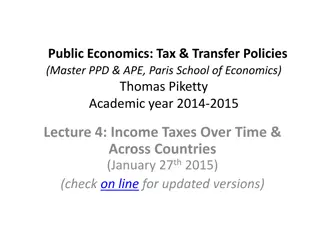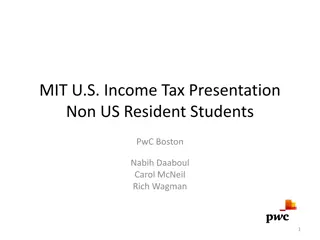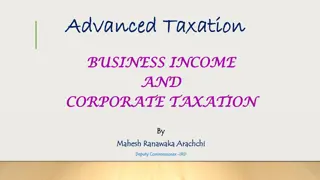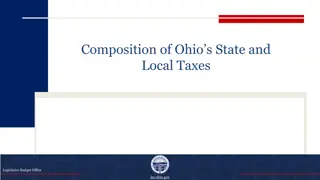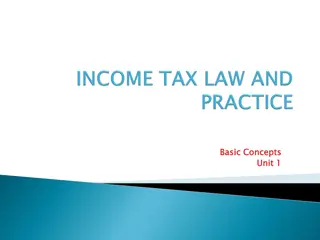Understanding Residential Status for Income Tax Assessment
Residential status under Indian income tax laws plays a crucial role in determining tax liabilities for individuals. It is based on the amount of time spent in the country and distinguishes between residents, non-residents, and residents but not ordinarily residents. The classification impacts taxability for various categories of taxpayers. Learn about the steps and categories involved in determining residential status to comply with income tax regulations.
Download Presentation

Please find below an Image/Link to download the presentation.
The content on the website is provided AS IS for your information and personal use only. It may not be sold, licensed, or shared on other websites without obtaining consent from the author. Download presentation by click this link. If you encounter any issues during the download, it is possible that the publisher has removed the file from their server.
E N D
Presentation Transcript
The term residential status has been coined under the income tax laws of India and must not be confused with an individual s citizenship in India. As a matter of fact, most of the other steps of assessing taxes and filing returns are heavily dependent on the residential status of an individual. Residential status is the status of the amount of time that a person spends in the country. Based on the amount of time (days) spends in the country, the income tax department has outlined a few categories of residential status. The rationale being, understanding the residential status is the first step For income tax purposes for a particular year
An individual may be a citizen of India but may end up being a non-resident for a particular year. Similarly, a foreign citizen may end up being a resident of India. A person shall be deemed to be of Indian origin if he or either of his parents or any of his grandparents was born in India or undivided India The residential status of different types of persons viz an individual, a firm, a company etc is determined differently. The taxability of an individual in India depends upon his residential status in India for any particular financial year.
INCOME TAX Presented by Dr.M.THIRUNARAYANASAMY Associate professor and Head Department of Commerce PS.PT. M.G.R Govt Arts and Science College Sirkali Puthur Nagai District Deputed From Annamalai University
Determination of Residential Status Determination of Residential Status of an Individual of an Individual To individual, the first step is to ascertain whether he is resident or non-resident. If he turns to be a resident, then the next step is to ascertain whether he is resident and ordinarily resident or is a resident but not ordinarily resident. The taxability differs for each of the categories of taxpayers. For the purpose of income tax in India, the Indian income tax law persons as: determine the residential status of an classifies taxable
RESIDENTIAL STATUS of an Individual ( U/S (6) RESIDENTIAL STATUS Resident (U/S 6(1) Non-Resident (u/s 2 (30) U/S 6 ( 6) Ordinary Resident but not ordinary resident Resident
Steps in Ascertain Residential Status of an Individual Step 1 : First ascertain whether the individual is resident or non- resident Step 2 : Secondly ascertain whether he is ordinarily resident or not ordinarily resident. Step 2 is to be performed only if the individual turns to be a resident.
Step 1: Determining whether Step 1: Determining whether Resident or non Resident or non- -Resident Resident Under the Income-tax Law, an individual will be treated as a resident in India for a year if he satisfies any of the following conditions (i.e.may satisfy any one or may satisfy both the conditions): Under section 6 (1) ( i) and (ii) 6 (1) ( i) : He was in India for a period or periods totaling in all to 182 days or more during relevant previous year . or 6 (1) (i i) He was in India for a period or periods totaling in all to 60 days or more during relevant previous year and 365 days or more during 4 previous years immediately preceding the relevant previous year. Relevant previous year means the previous year for which the residential status is being determined. If an individual does not satisfy any of the above conditions he will be treated as non-resident in India.
Step 2 : Determining whether Step 2 : Determining whether RESIDENT AND ORDINARILY RESIDENT RESIDENT AND ORDINARILY RESIDENT or or Resident But Not Ordinarily Resident Resident But Not Ordinarily Resident A resident individual will be treated as resident and ordinarily resident in India during the year if he satisfies following conditions: U/S 6 (6) (a) He must be resident in India for at least 2 years out of 10 years immediately preceding the relevant previous year. AND U/S 6 (6) (b) His must be stayed in India is for 730 days or more during 7 previous years immediately preceding the relevant previous year. A resident individual who does not satisfy any of the aforesaid conditions or satisfies only one of the aforesaid conditions will be treated as resident but not ordinarily resident.
Important Note Important Note While calculating number of days stayed in India both day of departure from India and day of arrival in India are to be counted as stay in India
Example:1 Mr A , an Australian cricket player has been coming to India for 100 days every year since 2005-06: (a)Determine his residential status for the assessment year 2019-20. (b)Will your answer be different if he has been coming to India for 110 days instead of 100 days every year.
Solution : As As per per Sec Sec 6 6 ( (1 1) ) (i) (i) He He was was in the the previous previous year in India India for year. . for a a period period or or periods periods of of 182 182 days days or or more more during during Mr Mr. .A A Does in in India India every Does not every years not satisfy satisfy this years. . this condition condition because because he he was was only only 100 100 days days As As per per Sec He He was was in the the previous previous year immediately immediately preceding Sec 6 6 ( (1 1) ) (ii) in India India for (ii) for a a period period or year and and for preceding the or periods periods of period of the relevant relevant previous of 60 365 days days or previous year 60 days days or or more year. . or more more during more in in 4 4 years during years for a a period of 365 Mr Mr A A was was in the the relevant relevant previous preceding preceding the the relevant satisfies satisfies the in India India for the second second condition for more more than than 60 previous year year and relevant previous previous year condition of 60 days days ( (100 and for for 400 year. . Therefore, Therefore, he of category category (A) 100 days days every 400 days days during (A) because because he every year) year) during during four four years he is is a a resident resident. . he during years Further, in this case, although he satisfies the first condition of category (B) of being resident for at least 2 out of 10 preceding previous years but he does not satisfy the second condition of category (B) as during 7 years preceding the previous year, he is in India for only 700 days. He shall, therefore, be a resident but not ordinarily resident in India.
He He was was in more more during during the or or more more in previous previous year in India India for the previous previous year in 4 4 years years immediately year. . for a a period period or year and immediately preceding or periods periods of and for for a a period preceding the of 60 60 days days or of 365 365 days the relevant relevant or period of days (b) Yes. He will, in this case, be resident and ordinarily resident in India. He satisfies both conditions of category u/s 6 (6) a and b as he was in India for 770 days in the last seven years and he was resident for at least 2 previous years out of 10 previous years immediately preceding the relevant previous year.
Example 2 Mr Nithilan an Indian citizen leaves India for the first time on 31st may 2014 and comes back on 15thmay 2017. he again leaves India on 10thJune 2018 and come back on 14thJanuary 2019. He is living in India since then. Determine his status for the previous year 2018-19.
Solution Relevant Previous year 1-04-2018 to 31-03-2019 Number days stayed in India Previous Year 2018-19: ( on 10thJune 2018 he leaves India) He was in India (1-4-2018 to 10-06-2019) Ap 30 + may 31+june 10 = 71 days He return to India on 14thJanuary 2019 He was in India (14-01-2019 to 31-03-2019) (Jan 18 +Feb 28+March 31 days) = 77 days) Total days in India in the previous year (71+77) = 148 days No of days in 4 previous year preceding to relevant previous year 2017-2018 = in India ( 15-05-207 to 31-03-2018) = 322 days 2016-2017 = Not in India 2015-2016 = not in India 2014-2015 = in India (1-04-2014-31-05-2014) = 61 days Total = (322+61) = 383 days. Test 1: Sec 6 (1) (i) must be in India 182 days in India is not fulfilled Test 2: Sec 6 (1) (ii) must be in India 60 days or more in India and 365 days or more during 4 previous years immediately preceding the relevant previous year.is fulfilled Hence He is resident u/s 6 (1)
Solution Cont---- Before 2014-2015 he was in India in all the days of all years because he leaves India for the first time on 31st may 2014 only. So we should understand that He was resident 2 years out of 10 years u/s 6 (6) (a) And He was in India 730 days in 7 previous years preceding previous year. Therefore He is ORDINARY RESIDENT ORDINARY RESIDENT



